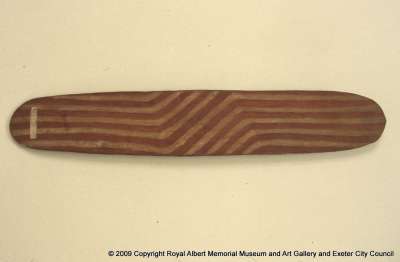Shield
Adorned with bold zigzag patterns consisting of a series of longitudinal grooves accented with red and white ochre, wunda shields were once used across a large portion of the vast state of Western Australia. Although widely distributed in the region, the shields appear to have been produced mainly by peoples living in the area between the Gascoyne and Murchison rivers, which drain into Australia's western coast, and traded to other groups along a vast network of inland exchange routes. Like many forms of Aboriginal shields, wunda were used in fighting for protection against projectile weapons, such as spears and boomerangs. They were also carried by performers in ritual contexts, especially when re-enacting specific episodes from the Dreaming (primordial creation period), in which ancestral beings were said to have been armed with shields.
The formal layout of the designs on wunda shields occurs in two basic patterns. In the first, known as pandal, which is seen on the present work, the lines in the upper and lower registers of the shield are arranged vertically along the axis of the shield, while those in the central register appear at an oblique angle. In the second, called pangkurda, the lines in the upper and lower registers run obliquely and those in the central section are horizontal. Zigzag designs in Western Australia appear to have been widely associated with rain and water. Broad patterns formed from nested zigzag motifs, such as those that appear on the wunda shields, are variously interpreted as representing ripple marks on the sand, floodwaters, or the ripples made by the wind on the surface of large bodies of water.
The formal layout of the designs on wunda shields occurs in two basic patterns. In the first, known as pandal, which is seen on the present work, the lines in the upper and lower registers of the shield are arranged vertically along the axis of the shield, while those in the central register appear at an oblique angle. In the second, called pangkurda, the lines in the upper and lower registers run obliquely and those in the central section are horizontal. Zigzag designs in Western Australia appear to have been widely associated with rain and water. Broad patterns formed from nested zigzag motifs, such as those that appear on the wunda shields, are variously interpreted as representing ripple marks on the sand, floodwaters, or the ripples made by the wind on the surface of large bodies of water.
Object Summary
- Accession Loan No.
- 33/1953/27a
- Category
- Ethnography
- Collection Class
- Arms and armour
- Material
- woodpigment (white ochre)pigment (red ochre)
- Common Name
- shield
- Simple Name
- shield
- Production Town
- Onslow
- Production County
- Ashburton district, Western Australia
- Production Country
- Australia
- Production Year Low
- 1800
- Production Year High
- 1912


